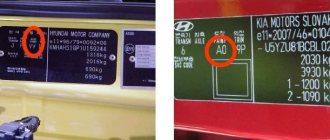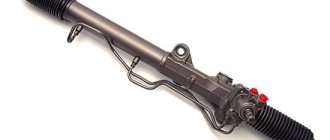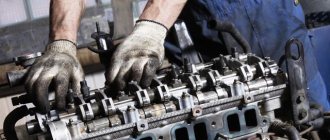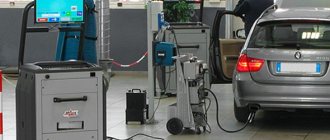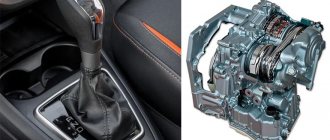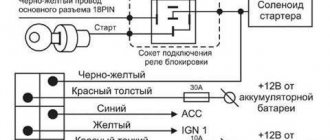The steering mechanism of a modern car has become noticeably more complex and technologically advanced compared to analogues that were actively used previously. At first, the steering was equipped with power steering, later versions with power steering appeared. Today, combined systems are increasingly common, when hydraulics, mechanics and electronics are actively involved.
One way or another, many passenger cars (both with hydraulic booster or electric booster, and without such solutions) invariably use rack-and-pinion steering. At the same time, one of the main components of such steering remains the steering rack. The quality of operation of this unit directly affects the comfort of driving, steering efficiency, and safety.
Next we will look at what a steering rack is, how it works and how it works. Also, within the framework of this article, we will study what signs of a broken steering rack you should definitely pay attention to, how to check the steering rack, how to repair the steering rack, etc.
Types of steering racks
There are three types of steering racks in modern cars:
- electrical;
- mechanical;
- hydraulic.
The mechanical steering rack has a simple device. At the end of the steering column there is a gear mechanism that is interconnected with a gear rack, which, in turn, communicates with the steering drive.
A hydraulic steering rack is implemented in most modern passenger cars. Power steering (power steering) increases the return on the effort exerted by the driver, and thereby ensures easy and comfortable driving.
The electric steering rack also improves the driver's response, but for this it uses an electric motor rather than a hydraulic booster.
The steering rack may be positioned differently in different car models. With the upper position of the rack, it is attached to the body and is located behind the engine; with the lower position, it is attached from below to the body, subframe or beam.
Steering: types of steering racks and operating principle
Let's start with the fact that since the appearance of the first cars, the rack and pinion mechanism has already been actively used in the steering device. At the same time, the cars were slow; the driver did not apply much force to the steering wheel to make turns or turn around.
However, later cars became heavier, more powerful and faster, the wheels became wider and smaller in size. Of course, the steering effort also increased. To compensate, they began to increase the diameter of the steering wheel, reduce the gear train, change the transmission mechanisms themselves, etc.
Ultimately, it became clear that the steering rack, even taking into account the existing shortcomings, is still the best mass option in terms of technology and production costs. Subsequently, by equipping such a rack and pinion mechanism with a hydraulic booster, it was possible to obtain an optimal solution for a number of indicators.
As a result, passenger cars have the following types of steering racks:
- steering rack without power steering (on old and budget cars);
- steering rack with hydraulic booster (power steering);
- electric power steering rack (EPS);
The last two types are actively used today on mid- and high-class models. Also on luxury cars you can find combined systems (electric power steering).
This scheme means that a hydraulic amplifier works in tandem with an electric amplifier controlled by complex electronics. This allows you to dynamically and flexibly change steering settings depending on specific conditions, as well as taking into account the individual preferences of the driver.
For example, at high speed you can “heavier” the steering wheel, improve feedback, make the steering wheel “light” in a parking lot, and also change some other parameters and characteristics of the steering. In any case, regardless of the complexity of the system itself, the main element remains the steering rack. Now let's look at the types of steering racks and features in more detail.
- So, the main purpose of the steering rack is to convert and transmit force from the steering wheel to the steering rods. In fact, the steering rack is responsible for converting the movement of the steering wheel into turns of the steered wheels in the horizontal plane.
This transformation is possible due to the fact that the rack has a worm gear, to which the force is transmitted from the steering column gear. This worm gear transmits force to the toothed part of the rack.
The general structure of the steering rack is as follows:
- Steering rack housing/housing (usually made of aluminum) to protect the steering rack;
- The gear (worm) rotates from the steering column and is connected to the steering column through a bearing;
- A steering rack or toothed shaft having a section of teeth that mesh with a gear. The shaft and gear are made of durable steel, the top layer of the parts is extremely wear-resistant.
- Springs to ensure reliable fixation and tight engagement;
- Limiters on the range of motion of the shaft in the form of a cuff on one side and a steering rod bushing on the other side.
To make it clear, when the driver turns the steering wheel, through the shaft in the steering column, force is first transmitted to the worm gear (worm), as a result of which the rack mounted in the housing (steering rack shaft) moves left or right. In turn, steering rods are attached to the ends of the shaft.
Also, depending on the type, a power steering system may be attached to the rack. Simply put, these are hydraulic lines and a pair of cylinders, which, due to filling with oil, move the steering rack synchronously with the movement of the steering wheel.
If you don’t apply force to the steering wheel, there is no pressure on the shaft. In the case of an electric power steering system, sensors and a servomechanism (electric motor) are attached to different sections of the rack depending on the design features (on the housing, on the shaft, etc.).
- As for the mechanical rack, it is a simple design that directly transfers the force from the steering wheel to the wheels. In terms of feedback, this is the best solution, since there are no intermediate amplifiers. This design is also reliable and simple, but that’s where the advantages end. The fact is that driving a car with such a steering mechanism is more difficult and difficult, especially if you need to turn the wheels on a stationary car. Shocks and vibrations from the wheels are also transmitted to the steering wheel.
For this reason, this type of steering mechanism is found exclusively on old cars (for example, discontinued domestic VAZ models, foreign cars from the 70-80s, etc.) or on new cheap cars produced for markets in developing countries (for example, ZAZ “Sens” model).
- In turn, a hydraulic rack (rack with power steering) is the most common type of steering. Simply put, a power steering rack works in such a way that when the steering wheel is turned, the gear shaft inside the rack housing “pushes” oil supplied from the power steering pump under pressure. As a result, the driver does not exert much effort on the steering wheel.
The disadvantages include the fact that the design of such a rack is more complex than a simple mechanical analogue. First, the power steering pump connected to the engine takes away engine power and may fail. The power steering also requires periodic maintenance (at a minimum, the power steering oil needs to be changed). The presence of liquid under pressure inside the system also implies complete tightness, which entails the need to use a large number of gaskets, seals, seals, etc.
One way or another, the rack with power steering is actively used on passenger cars, SUVs, trucks and other types of wheeled vehicles. The system has been time-tested and has proven itself to be quite reliable. This solution provides high-quality amplification and allows you to achieve good feedback.
This allows you to drive your car efficiently and safely at different speeds, and also not experience difficulties when parking. As for reliability, in practice, a power steering pump can last more than one hundred thousand kilometers, and a rack with power steering can easily travel at least 100-150 thousand km. without repairs or maintenance.
- A rack with electric power steering (EPS) was originally created as a simpler and cheaper replacement for power steering. In short, this is a regular mechanical rack, but an electric power steering (actually an electric motor) and sensors are separately attached to the steering column or the rack itself. In a nutshell, when you turn the steering wheel, the rotation sensor and a number of other sensors are triggered, which send signals to the ECU. Then the control unit sends a signal to the electric motor, which creates the necessary force.
This system was initially positioned by manufacturers as more compact, cheaper and more convenient compared to power steering. However, in reality, the first versions of the electric power steering had a number of shortcomings (frequent failures and malfunctions, uneven force on the steering wheel when turning in different directions, spontaneous operation of the amplifier, etc.).
Drivers also noted that the feedback of such steering is much worse than versions with power steering. In fact, due to excessive reinforcement, the steering could be too “light” at high speeds, which is very dangerous.
It can also be noted that although in terms of design, the EUR seems simpler to many than the power steering, the reliability and maintainability of such a system turned out to be no higher, and often lower, than that of power steering. The reason is that the electric booster motor itself is difficult to properly repair, a new rack with an electric booster is expensive (sometimes more expensive than a rack with a hydraulic booster), there are fewer repair specialists, etc.
Of course, manufacturers subsequently refined the system, thereby increasing efficiency and reliability. However, a number of issues have still not been resolved, which does not allow the more modern power steering to quickly and confidently displace power steering from the market. It becomes clear that it is the power steering that, until today, has been and remains one of the most reliable, comfortable and proven solutions.
Causes of knocking in the steering rack
The main reasons for steering rack failure are driving on uneven roads and frequent hard braking. When the car moves over bumps and holes, accelerated wear occurs on the plastic support sleeve on the right or left side of the rack. As a result, play appears, which causes a knock in the steering column.
A knock may also occur due to weak tightening of the steering mechanism fasteners. In this case, it is not difficult to get rid of the knocking noise; you just need to tighten all the bolts and nuts on the connections.
The third reason for knocking in the steering rack is damage or abrasion of the protective rubber covers. Damage to the covers leads to the penetration of dust and dirt particles inside the mechanism, accelerating the wear of the rack and sliding support.
Corrosion is not a car’s best friend, as it wears away at the bushing and leads to a monotonous knocking sound. In case of corrosion, the knocking problem can only be solved by replacing the rusty part.
Finally, the bushing wears out due to the fact that it is made of insufficiently rigid material, which during off-road driving becomes deformed and ceases to perform its functions. In order for the part to last for a long time, it is better not to buy a new one in the store, but to machine a similar one from a more durable material, for example, caprolon.
Useful tips
It should be noted that the main reasons for premature failure of the steering rack are considered to be:
- moisture and dirt getting inside the mechanism;
- high shock loads (driving on bad roads);
- low quality of node service;
First, racks usually fail due to the fact that water and dirt get into the rack through damaged boots in the area where the steering rods are attached. This leads to corrosion and active destruction of the shaft and other parts. As a result, the shaft begins to knock, rack versions with power steering leak, etc. To prevent this from happening, the condition of the steering rod boots must be monitored, since even slight damage to the boot will quickly disable the sensitive mechanism.
We also recommend reading an article about the reasons why the power steering hums, as well as what breakdowns lead to the power steering humming. From this article you will learn about the main malfunctions and reasons why the hydraulic booster howls or the power steering hums, as well as how to diagnose and repair such malfunctions.
Also, the rack usually breaks if the owner does not follow the basic rules of maintenance and operation of this unit. These rules apply to all types of racks, but are more directly related to power steering and similar solutions where working fluid (power steering oil) is poured into the steering rack.
To extend the service life of the unit, you should check the oil every 10-15 thousand km, monitor the level and condition of the oil in the power steering reservoir. Changing the oil in the power steering is recommended every 60-80 thousand kilometers. Also, during operation, the oil should not be dirty, change its color, there should be no foreign impurities in the oil, a burning smell, etc.
If a change in the condition of the oil is noticed, regardless of its service life, it should, at a minimum, be completely replaced. In a situation where the oil is old, the power steering does not work correctly and replacement does not help solve the problem, in-depth diagnostics of the steering rack, power steering pump and other elements of the system are necessary.
As for operation, you should not leave the car in the parking lot with the wheels turned out, and it is also forbidden to hold the steering wheel in the extreme position while turning for more than 5 seconds. In the first case, when the engine starts with the wheels turned, the rack with power steering wears out greatly, and in the second, the oil in the rack quickly overheats. Also, when driving, you should carefully cross uneven surfaces, and also reduce your speed to a minimum when crossing curbs or completely abandon this practice.
Even before driving in the cold season, it is also advisable to warm up the power steering by turning the steering wheel at low speed one or half a turn to the left and right. However, experts do not recommend doing this on a stationary car.
Fault diagnosis: how to do it yourself?
You can diagnose the problem yourself, or contact a car service center for help. Diagnostics will determine whether the unit can be repaired or will need to be replaced. Diagnostics are carried out in the inspection pit with the engine turned off. To diagnose yourself, you need to follow these steps:
- turn off the engine, put the car on the handbrake or put an assistant behind the wheel;
- climb down, closer to the place where the rail is located;
- ask an assistant to alternately turn the steering wheel right and left until it stops;
- try to determine where the knocking is coming from;
- inspect the steering rod joints for gaps;
- inspect the protective boots for damage and lubricant leaks;
- begin repairing detected faults.
If self-diagnosis does not allow you to identify the malfunction, you should contact a car service center for help.
Adjustment features
On a note! You should not tighten the adjusting bolt too much, since while driving or turning, a dangerous phenomenon may occur—biting.
View gallery
You need to adjust it like this: turn the bolt a maximum of 20 degrees, after which you need to drive it and check whether the knocking noise from the steering rack of the Lada Kalina has disappeared. If the vibration remains, you can tighten the bolt again, but by a maximum of 15 degrees.
However, if repeated tightening does not produce any results, it is necessary to overhaul the steering rack. In this case, the steering tips, oil seals, and anthers are replaced.
The simplest DIY steering rack repair
After identifying a malfunction, the car owner can:
- try to fix the rack yourself;
- seek help from a specialist;
- carry out a complete replacement of the unit.
If the gearbox cannot be restored, you will have to install a new one instead. Buying a gearbox will cost the car owner a tidy sum, but a new part will last longer than a reconditioned one.
If the cause of the knocking in the steering rack is the tips, then the car owner will get off with a “slight fright” by paying a small amount to replace them at any car service center. Without the appropriate skills and tools, it is not recommended to repair the tips yourself.
If diagnostics have shown that the knocking comes from the junction of the rack and the rod, then this defect can be eliminated independently. To do this you need to do the following:
- remove the protective boot and remove the grease;
- if the bushing is damaged, replace it;
- clean the spring from dirt; if necessary, remove it and wash it with diesel fuel or a special liquid;
- if there is damage to the boot, including microscopic tears and cracks, then it should be replaced;
- tighten the bolt that regulates the movement of the sleeve, being careful not to overdo it and damage the entire mechanism.
Finally, it is necessary to reassemble the steering components and once again check how it works. If you did everything correctly, the knocking noise in the steering rack will disappear. If repairs do not help solve the problem, it is better to seek help from a specialist.
If a power unit with a hydraulic booster is installed on the car, then before dismantling it, the high-pressure pipes should be released and the working fluid should be drained into a clean container. Before removing the power steering gearbox, you should remove the car subframe. It will not be possible to do this without outside help. Therefore, it is better to invite an assistant in advance, or take the car to a car service center.
IMPORTANT! To repair the steering rack yourself, it is better to use a special kit, which includes new oil seals, seals and a bushing. Such kits are sold at car markets and auto shops.
Faults, diagnostics and repair of the steering rack
As mentioned above, there are three main types of steering racks:
Currently reading:
Replacing tie rods and ends: what you need to know
Jun 21, 2020
What oil to fill in Kia Rio: what you need to know
Jun 21, 2020
- mechanical;
- hydraulic;
- electric;
Combined systems can also be distinguished, however, such solutions are not so widespread and are usually found on expensive high-class cars. One way or another, there are both general problems for all types, and breakdowns that depend on the specific type of steering rack.
In any case, you need to remember that the steering rack is far from the cheapest component. For this reason, when the slightest sign of malfunction appears, the steering rack needs to be diagnosed, after which a decision is made to repair or replace the unit.
First, the driver needs to know the signs of a faulty steering rack. As a rule, the main reason for the failure of this unit is a malfunction of the control electronics, a leak of working fluid, or severe wear of individual parts.
The problem will be indicated by a decrease in the level of working fluid (oil) in the reservoir of the system with hydraulic booster or electric hydraulic booster. If there is no oil leak, then the main signs of rack problems are considered to be:
- a clear change in the force on the steering wheel (usually in the direction of weight);
- the steering wheel turns jerkily, jerkily, the force is uneven;
- at certain points the steering wheel “wedges” (the rack bites);
- When driving over uneven surfaces, a knocking sound is heard and the steering wheel begins to wobble;
- there is noticeable play in the steering column;
If even one of these symptoms appears, a diagnosis is needed. To check on a specific car, you need, at a minimum, to lift the car on a lift, inspect the rack and boots for damage to the body, cracks, and oil leaks.
You also need to evaluate the play in the area of the steering rods, on the steering column; the force on the steering wheel is checked separately, etc. If the system is complex (especially with electric power steering and combined solutions), special attention is paid to electronics, sensors, and servomechanisms (computer diagnostics are often necessary).
It should be remembered that you cannot delay checking the rack. The fact is that even the slightest malfunction will progress, and operating a car with faulty steering is unsafe and can cause an accident.
It is also important to consider that in some cases, at the initial stage, it is possible to stop the destruction of the rail, that is, limit it to repairs. If the problem is ignored, over time the unit will be damaged so badly that only its complete replacement will be necessary, which is quite expensive.
When it is determined that the steering rack is faulty, repair is often possible. To do this, you need to purchase a steering rack repair kit. As a rule, a repair kit for a steering rack involves the possibility of replacing a number of components as part of the overhaul of this unit.
Often, such a kit contains boots, oil seals and o-rings, as well as bearings, support bushings and sliding bushings, springs, etc. Such parts allow you to restore the functionality of the steering rack without the need to completely replace the unit.
However, this solution is only suitable for slats that are naturally worn. If the rack is damaged (broken), the shaft is corroded, there are problems with the spool mechanism, etc., in such a situation, either a complete restoration of the steering rack or replacement with a new unit is necessary. As a rule, the second option is preferable, but it turns out to be noticeably more expensive.
In turn, restoration of the steering rack involves grinding the gear shaft, restoring the teeth, making bushings and oil seals to new sizes, sandblasting the rack body, etc. The quality of work and reliability of such a unit will directly depend on the experience and qualifications of the specialist performing the repair.
How to extend the life of a steering rack
There are a few simple rules that will help extend the life of the steering rack of any car.
Firstly, you need to give up reckless driving through pits, the habit of sharply accelerating and braking at the last moment, since such maneuvers have a detrimental effect on the steering rack. The key to a healthy rack is a smooth driving style.
Secondly, you need to learn how to park correctly. When using a curb as a motion limiter, each blow to the wheel is transmitted to the steering, which gradually becomes unusable.
Thirdly, you should periodically carry out maintenance of the entire mechanism, monitor the reliability of the fastenings and the serviceability of the protective covers. Timely replacement of damaged parts and boots will help extend the service life of the steering rack.
Fourthly, when using a hydraulic steering rack, you need to promptly change the hydraulic fluid in the power steering system, and also not leave the wheels in the inverted position during the winter months, so as not to accelerate the wear of the rack.
What's the result?
Taking into account the information provided, it becomes clear that the steering rack is the most important element in the steering control of many cars. Comfort and safety depend on the quality and efficiency of the slats. However, many steering racks are equipped with a power steering, which means the need for periodic checks and regular maintenance (especially in the case of power steering).
We also recommend reading the article on how to change the power steering oil yourself. From this article you will learn what kind of oil to pour into the power steering, what needs to be taken into account when selecting power steering oil, as well as how to change the oil in the power steering and what features you should pay attention to as part of this procedure.
Finally, we note that there should be no failures in the operation of the steering; any deviations from the norm are unacceptable and are the basis for professional diagnostics, repair or replacement of a damaged or worn-out unit. At the same time, timely measures taken taking into account the signs of problems discussed above often make it possible to avoid expensive restoration of the steering rack, replacement of the steering rack with a new one, etc.
The main thing is that all repair and maintenance work is carried out by experienced specialists. Otherwise, malfunctions and steering failures cannot be ruled out, which can lead to serious accidents and other consequences.
How much will it cost to repair a steering rack?
If diagnostics of the malfunction showed that the steering rack needs to be replaced, then the car enthusiast will have a logical question: how much will such a pleasure cost him? It should be noted that prices for spare parts for foreign cars are an order of magnitude higher than prices for spare parts for domestic cars. Their specific values depend on the make of the car and the year of its manufacture.
So, for a VAZ car you can buy a steering rack without rods, ends and power steering for $130. The same assembled part will cost $230. To purchase a rack, the owner of a foreign car will need from 200 to 500 dollars, and the purchase of an assembled rack will require an investment of 1000-1500 dollars and more. If the car owner turns to the car service staff for help, then to the cost of the rack he will have to add the cost of paying for the services of specialists who will perform the repairs.
Repair of Lada Kalina steering wheel
The Kalina steering rack, like any other model of the domestic automobile plant, can exhibit knocking noise when operating on uneven surfaces. In addition, when driving, shocks are transmitted to the steering wheel. Before carrying out repairs, you need to figure out why the steering rack is heard. The Lada Kalina may make a knocking noise due to a loose adjustment screw or severe wear and tear and improper operation of the car.
View gallery
To adjust, you will need keys 10 and 13, as well as a puller for the steering wheel. To do this, there is no need to drive the car into a pit or onto a lift. All operations are carried out directly in the engine compartment.
To adjust the rack, it is necessary to remove the battery, since its location interferes with the work being carried out. Using a 10mm wrench, remove the terminals, and using a 13mm wrench, unscrew the battery fastening tie.
After removing the battery, you need to remove the stand underneath it, which is secured with 4 bolts. This will allow full access to the steering rack. On the bottom side of the housing there is an adjusting bolt with an internal plastic cap, which also needs to be removed. After these procedures, you need to tighten the traction using a special key.
Replacing the mechanism
Removing and replacing the steering rack is a similar process for most vehicles. The only difference is how it is dismantled. Before removing and replacing this power unit, find out what type of power unit is installed on your particular vehicle - electric power, hydraulic power, or a simple rack and pinion mechanism.
If your car is diagnosed with a simple rack and pinion mechanism, then first release the fastenings of the steering tips, then loosen the bolt fastenings, and then remove the universal joint.
Before dismantling the power steering rack, you need to release the high pressure pipes, and only then drain the working fluid into a clean container.
It is not recommended to remove the hydraulic power steering gearbox yourself, since to dismantle it you must first remove the car's subframe, which is impossible to do alone.
The video shows the steering rack being replaced:
Reasons for the occurrence of shocks
The steering rack consists of the main components:
- tip;
- Tie Rod;
- amplifier cylinder;
- input shaft gear.
The problem could be damage to any of these components:
- As one of the cases, you have to change the support bushings, which wear out quickly. Some craftsmen make homemade bushings (for example, from fluoroplastic), which often turn out to be more reliable and durable than the original ones.
- Rubber boots in the form of an accordion are put on the steering rack on both sides. If the boot wears out or tears, this can also subsequently lead to a knocking sound in the steering wheel. Getting moisture or dust inside any mechanism does not end well.
- Impacts are caused by breakage or wear of the teeth on the longitudinal rack or worm.
- Manufacturers save on the presence of transitional softening links, which often does not make it possible to reliably withstand impact forces when hitting holes and potholes (so familiar to us) on the roads.
We recommend:
Replacing the cabin filter on different Ford models
Most often, a knock begins to be noticed after the driver hits a large pothole (usually with the right wheel, because he sits on the left). Long-term driving on paving stones and dirt roads does not cure the condition.
